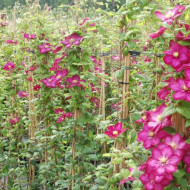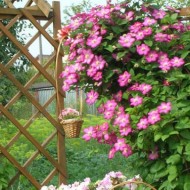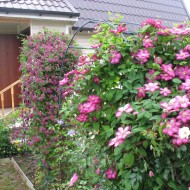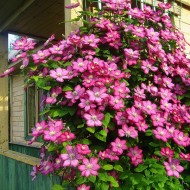We grow curly clematis Ville de Lyon in the country
Content
- 1 Breeding history of clematis Ville de Lyon
- 2 Video "Acquaintance with Ville de Lyon clematis"
- 3 Characteristics and description of the variety
- 4 Planting and caring for clematis Ville de Lyon
- 5 Methods for the control and prevention of diseases and pests
- 6 Application for landscaping a summer cottage
- 7 Gardeners reviews
Breeding history of clematis Ville de Lyon
Clematis, which are perennial woody or herbaceous plants, have more than 370 varieties. Perennials can be classified by flowering time, bud size, and pruning. The Ville de Lyon variety considered in today's article belongs to the group of late large-flowered clematis.

The birthplace of Clematis Ville de Lyon is romantic France. The large-flowered perennial was bred by French breeders in 1899. Despite such an impressive "age", the ornamental plant is still very popular with florists and gardeners in Western Europe, Russia, Belarus and Ukraine.
Video "Acquaintance with Ville de Lyon clematis"
This video tells about the features of growing an ornamental shrub.
Characteristics and description of the variety
The increased interest of breeders to large-flowered perennials is due to its high decorative qualities.
Ornamental qualities of the bush
Clematis Ville de Lyon is a shrub vine. The height of an adult plant is 2.5–3.5 m. With a favorable microclimate, vines can grow up to 4.5 m. Young shoots are characterized by a light brown color. Ligneous vines have a darker shade - rich brown or dark brown.
A distinctive feature of the variety is its small heart-shaped leaf plates. The color of the leaves depends on the amount of sunlight and can range from bright green to dark.
Flowering features
Ville de Lyon blooms in the second decade of July. The duration of flowering is determined by the weather conditions of the growing region. Most often, the flowering stage lasts until the first autumn frosts.
Since the variety belongs to large-flowered perennials, the diameter of the first flowers reaches 15–20 cm. The buds that open closer to the end of the growing season are smaller - up to 10 cm in diameter.
The shape of the flower is correct, rounded. The number of petals ranges from 5 to 7. The stamens located in the central part of the bud are pale yellow in color. The color of the petals changes from carmine red to deep purple. With active sunlight, the flowers fade, the petals acquire a pale pink hue.
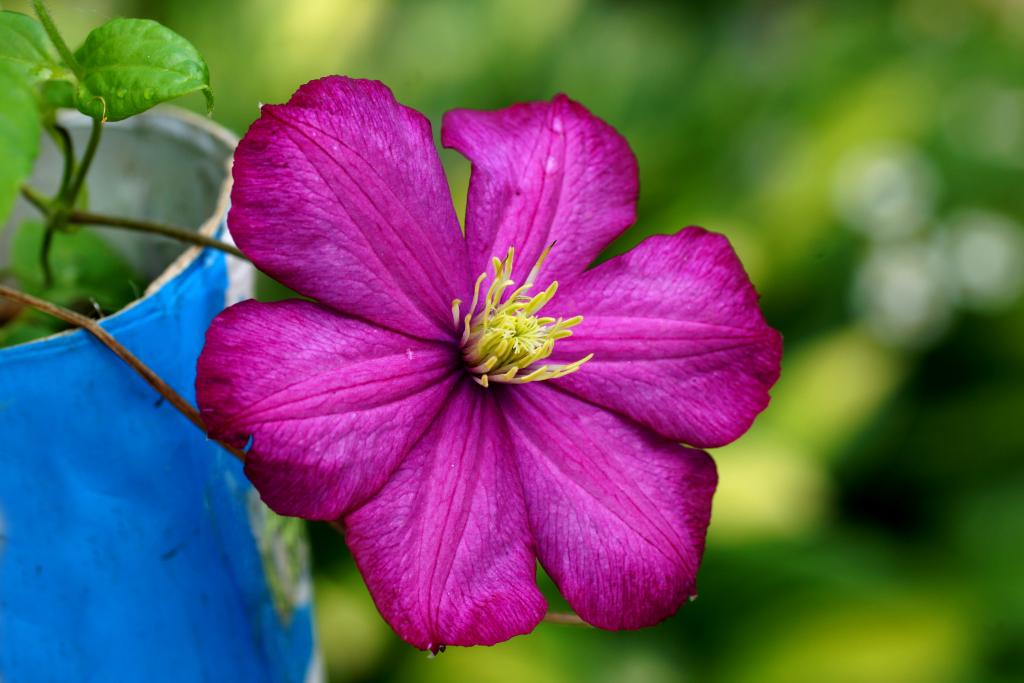
Frost and drought resistance
The popularity of clematis is due not only to its decorative qualities, but also varietal characteristics. The plant tolerates a lack of moisture in the soil.
With regard to winter hardiness, the Ville de Lyon variety does not require shelter for the winter in regions where the air temperature does not drop below -20 ° C.
Planting and caring for clematis Ville de Lyon
The decorativeness of large-flowered clematis Ville de Lyon depends on the correctly chosen growing place and compliance with certain growing conditions.
Recommended timing
Seedlings with an open root system can be planted in the ground in both spring and autumn. If planting is planned for the fall, it is better to perform the procedure in September or at the very beginning of October, before frosts come.
Closed-root plants, which are sold in special containers, are planted during the growing season. It is advisable to choose a dry and calm day.
Choosing a suitable location and soil
Clematis love active sun. However, excess sunlight negatively affects the growth and development of the root system. The best option is a well-lit area with little partial shade.
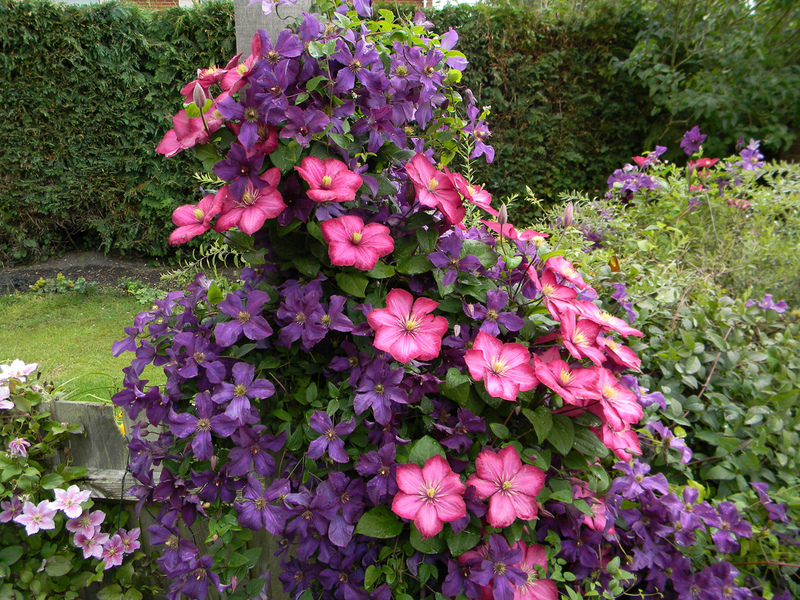
For normal life, perennials need loose and nutrient-rich soil. The shrub feels best in loamy soil with a neutral or slightly alkaline environment. The groundwater level is not higher than 1.5–2 m from the earth's surface.
Landing algorithm
Planting begins with the selection of a seedling. 2-year-old seedlings with a well-developed root system are distinguished by rapid adaptation to the new growing environment. A few hours before planting in the ground, the clematis root is soaked in a weak solution of potassium permanganate or in any growth biostimulator.
The average size of the planting pit is 60x60x60 cm. The depth and diameter of the planting pit may be slightly larger if the perennial root system is highly branched. The bottom of the pit is laid out with pieces of broken brick, crushed stone and coarse river sand. The drainage system facilitates the rapid removal of excess moisture.
A perennial seedling is planted in the center of the pit next to the installed support. In this case, the lower pair of buds should be deepened by 6–8 cm. At the end of planting, the plant is watered abundantly.
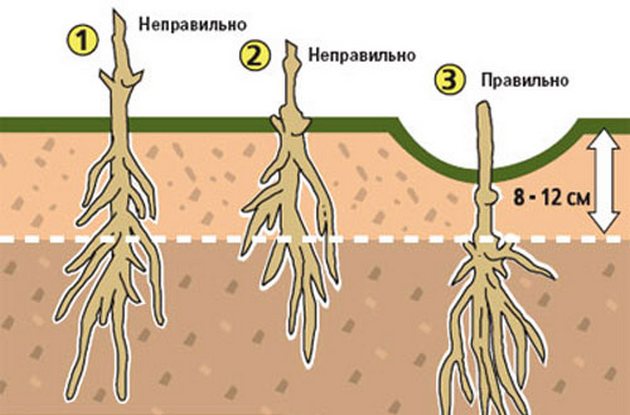
Watering and feeding
Clematis is drought tolerant. You need to water the perennial once every 4–6 weeks. If the summer is rainy, watering is completely canceled.
For abundant and rich flowering, Ville de Lyon needs regular feeding. In the spring, perennials are fed with lime diluted in water - 200 g of lime are taken for 1 bucket of water. During the growing season, complex mineral fertilizers are applied three times. In autumn, clematis is fertilized with wood ash and humus.
Mulching and loosening the soil
Saturation of the soil with oxygen prevents the development of fungal and bacterial infections. For this reason, it is recommended to periodically loosen the topsoil.
Mulching, in turn, prevents weed growth and maintains optimal soil moisture levels. Rotten mulch enriches the soil with nutrients and nutrients.
Plant pruning
One of the obligatory steps in caring for clematis is pruning the vines. During the growing season, dry, broken and damaged shoots are removed. In the fall, deep pruning of the shrub is carried out with almost complete shortening of the vines. Above the surface of the earth, "hemp" with 2-3 nodes are left.

Shrub shelter for the winter
Clematis growing in the south do not shelter for the winter.But in the central and northern regions, where the air temperature can drop below -20 ° C, perennial insulation is indispensable.
The trimmed ornamental bush is sprinkled with a layer of fallen dry foliage and humus. In severe frosts, plants in the garden should be insulated with a non-woven covering material.
Methods for the control and prevention of diseases and pests
Ville de Lyon is characterized by high immunity to fungal diseases. With improper care, it can be affected by fusarium and powdery mildew. The preventive treatment of perennials with a 1% solution of copper sulfate will help prevent the development of diseases.
To get rid of harmful insects - nematodes, slugs, snails, aphids and spider mites - insecticidal preparations "Fitoverm", "Fufanon-Nova" and "Fas" will help.
Application for landscaping a summer cottage
Perennial climbing vines are actively used in vertical gardening. So, the Ville de Lyon variety is often used to decorate the walls of buildings, garden columns, alcoves, semi-closed and closed gazebos, fences and other fences. As supports, you can use concrete pillars, metal reinforcement, or even trees growing on the site.
Large-flowered clematis planted along the netting mesh will eventually create a beautiful and bright hedge. The plant is often used to decorate entrances, balconies, railings and supports on terraces.
- Clematis garden design options
Gardeners reviews
“Recently I mastered the profession of a landscape designer and discovered a perennial, unpretentious in care, - clematis of the Ville de Lyon variety. Curly lianas can be used for natural decoration of outwardly inconspicuous outbuildings. "
“I have been growing clematis for many years. Ville de Lyon can be noted as one of the most unpretentious to growing conditions. With minimal care, the plant pleases with abundant and juicy flowering. "
The unpretentious Ville de Lyon variety clematis will become a real decoration of the garden. The tips and tricks for growing a perennial described in the article will help to increase the duration and intensity of flowering.

